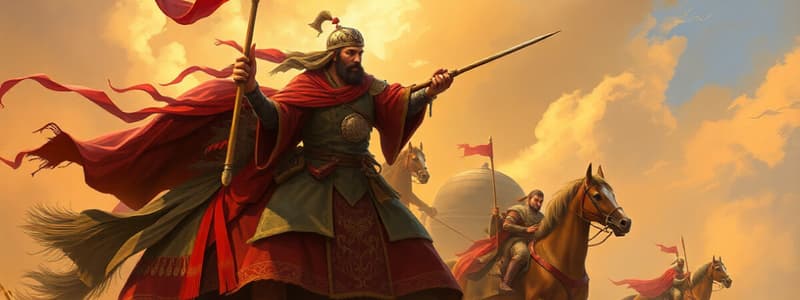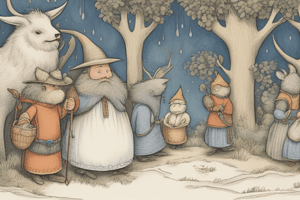Podcast
Questions and Answers
What was one of the key aspects of decision-making among the Mongols?
What was one of the key aspects of decision-making among the Mongols?
- Only high-ranking officials could propose decisions.
- All family members had a voice in decisions. (correct)
- Decisions were made by a council of warriors.
- Only the Great Khan made decisions unilaterally.
What term did the Mongols use to refer to the goods taken from conquered societies?
What term did the Mongols use to refer to the goods taken from conquered societies?
- Tribute
- Surplus
- Taxed goods
- Booty (correct)
What was one method the Mongols used to breach strong walls during sieges?
What was one method the Mongols used to breach strong walls during sieges?
- They dug tunnels under the walls.
- They utilized catapults and dead bodies as a form of German warfare. (correct)
- They employed skilled masons to build ladders.
- They sent diplomats to negotiate.
Which Mongol leader declared himself Muslim and sought to avenge the death of the Abbasid caliph?
Which Mongol leader declared himself Muslim and sought to avenge the death of the Abbasid caliph?
What was one consequence of the tax farming system introduced by the Mongols?
What was one consequence of the tax farming system introduced by the Mongols?
Who among Genghis Khan's descendants completed the defeat of the Tanggut and Jin empires?
Who among Genghis Khan's descendants completed the defeat of the Tanggut and Jin empires?
How did the Mongols manage their communication with outside regions?
How did the Mongols manage their communication with outside regions?
Which cultural elements did the Mongols blend into their society?
Which cultural elements did the Mongols blend into their society?
What method did the Mongols adopt from the Song dynasty regarding monetary policy?
What method did the Mongols adopt from the Song dynasty regarding monetary policy?
Which characteristic was NOT associated with the slaves of the Mongols?
Which characteristic was NOT associated with the slaves of the Mongols?
Flashcards are hidden until you start studying
Study Notes
Mongol Empire
- Mongols had a strong war strategy and lived off of tribute and booty, which they obtained from conquered areas, such as the Tanggut, Jin, and Aran empires.
- Mongols used a system of democracy where family units made decisions together, with everyone, including the Great Khan, having a voice.
- Slaves were used for all labor and work, and were obtained through war or from people who wanted to escape starvation.
- Mongols sometimes secured land and protection by providing slaves, livestock, silk, and cash to conquered areas.
- Mongols used the technology of conquered people, such as catapults, and even German warfare tactics to break through strong walls, such as launching plague-ridden corpses over walls.
Mongol Interaction with Islam
- Mongols, particularly the Il-Khanate, had a significant impact on the Islamic world, establishing a rule that spanned Iran, Azerbaijan, Mesopotamia, and parts of Armenia.
- The Golden Horde, established by the Mongols, conquered southern Russia and ruled over the indigenous Muslim population, who became known as Tatars.
- Mongols were initially seen as a threat by Europeans, but when Il-khanate's Ghazan converted to Islam, relations changed, leading to a wider spread of Islam.
- Timur, although denied a position as Khan, played a significant role in the Islamic world, sacking the Delhi Sultanate and challenging the Ottoman Empire.
- Batu, the leader of the Golden Horde, claimed lands belonging to the Il-Khanate and used his conversion to Islam to proclaim himself as ruler and avenge the death of the Abbasid Caliph.
Mongol Tax System
- Tax farming, a system where revenue collection was sold to merchants, was introduced to the Mongols through China and later spread to Asia, impacting the Ottoman Empire.
- Tax farmers were expected to collect taxes with interest, resulting in overtaxation and the displacement of farmers.
- The economic impact of tax farming led to widespread instability and discontent amongst the population.
Mongol Legacy
- The Mongol Empire left a lasting mark on history with its expansion and influence.
- Ögedei led the Mongol forces to significant victories against the Tanggut and Jin, but his death led to a suspension of campaigning, which spared Europe from further conquest.
- Batu conquered Russian territories, including Kievan Russia, Moscow, Poland, and Hungary.
- Güyük continued Mongol campaigns, conquering the Middle East and marking the end of the Abbasid Caliphate by sacking Baghdad and executing the Abbasid Caliph.
- Kublai Khan established the Yuan Empire and expanded Mongol influence across East Asia by conquering Champa and incorporating it into their tribute system.
Cultural Impact
- Mongols established a culture that blended Arabian and Chinese traditions, incorporating elements of Buddhism, Islam, and Persian influences.
- Mongol rulers fostered a culture of learning and intellectual exchange, as evidenced by Timur's practice of transporting scholars and artisans across his empire to share knowledge and skills.
Mongol Enemies
- Mongols faced numerous enemies during their reign.
- The Shogunate of Japan, in their resistance against Mongol invasions, implemented a four-step strategy: beheading Mongol soldiers and sending the bodies back, using a massive wave to defeat a Mongol force crossing into Japan, slaughtering survivors, and ultimately pushing the Mongol invasion efforts back towards the West and Europe.
- The Middle East played a prominent role in challenging the Mongol Empire and eventually contributed to its downfall.
- Mongols often used those who disagreed with their rule in military campaigns, forcing them to fight on behalf of the Empire.
Studying That Suits You
Use AI to generate personalized quizzes and flashcards to suit your learning preferences.




